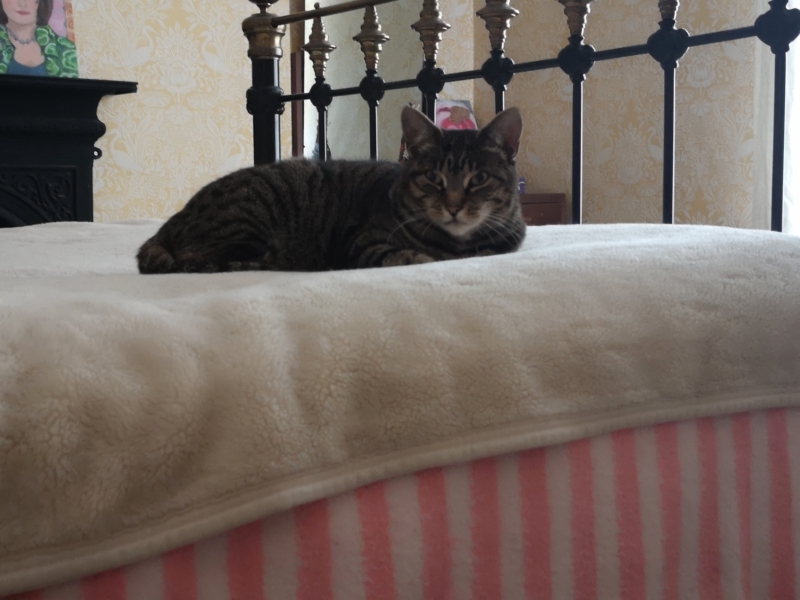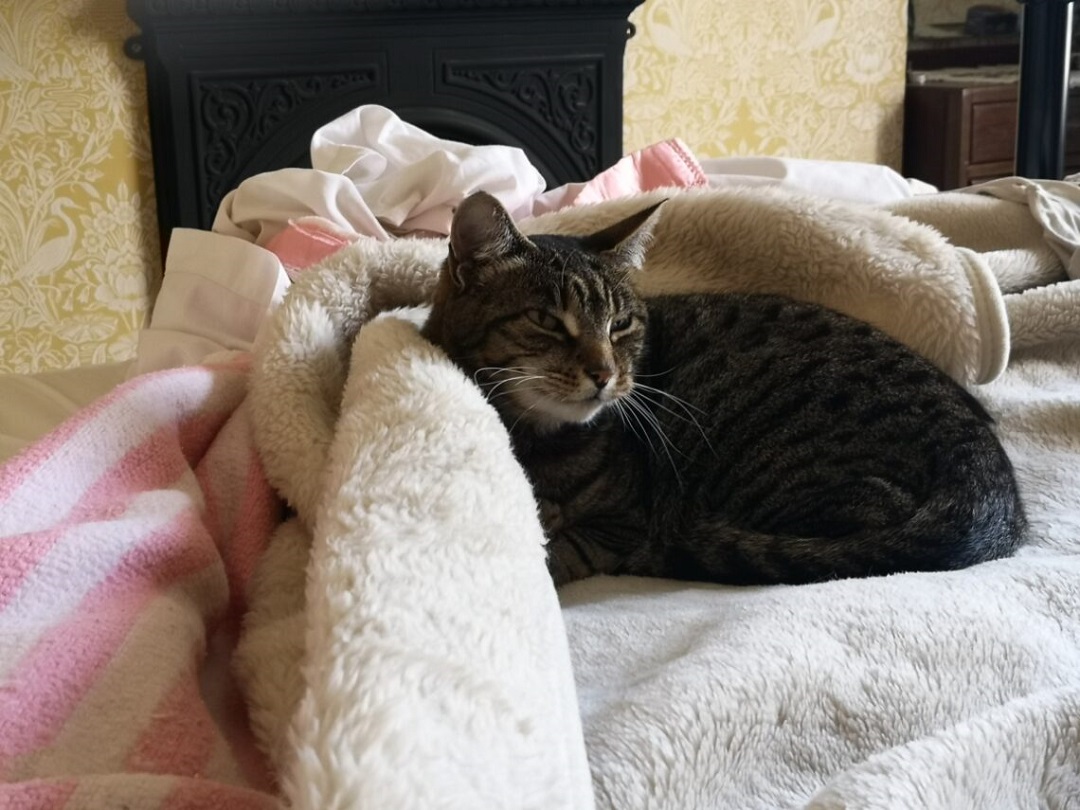I’ve gone back to sheets and blankets (traditional bedding) since we’ve redecorated and carpeted two bedrooms. Call me old-fashioned but I see many good points in what we’ve discarded and left at the back of linen cupboards.
What started me off on this was that we were one set of bedding down for our newly decorated bedrooms. A very old duvet and pair of pillows had bitten the dust, and I didn’t want to buy yet more synthetic fibre bedding. Homely, sustainable bedding is what came to mind.
Also fitting that bill is the desire, eventually, to use my copious supply of fabric remnants to make patchwork quilts for the beds. By that, I mean truly homespun, resourceful but attractive creations: no twee, perfectly matched colours and patterns for me. I figured, quilts go best with sheets and blankets. And, more importantly, pure wool blankets.
The pink stripey blanket is a pure wool one that came from my parent’s house. Topped with a not so natural fibre faux fur throw that we’ve had for a while, until I finally make those quilts.
The quilt is the ideal use for remnants and scraps. If you consider the classic log cabin quilt, then I question whether any fabric scrap is ever too small to save.
Likewise, left-over yarn. Left over yarn goes into crochet blankets, which until now have been sofa throw size. If that appeals, make one now. Make an Unplanned Afghan Blanket: Don’t Plan, Just Jump Right in.
Why Wool Blankets?
Back in 2013, Harry Wallop wrote in the Daily Telegraph about the duvet or blanket debate splitting the nation. He wrote:
This week the letters page of the Daily Telegraph has been rustling with the sound of blankets indignantly being shaken by a small band of hard-core wool enthusiasts, who have decided enough is enough.
Am I a hard-core wool enthusiast? Yes, I am – I love wool. It’s a natural, renewable, breathable fibre. Those sheep (your fibre-producers) grow new wool every year: after, greatfully, getting rid of the old one in spring. Courtesy of the sheep shearer. Wool has become so under-rated, and sheep fleeces virtually valueless now. Yet, wool could have a new lease of life – on your bed.
Years after the Daily Telegraph article, the sheets and blankets brigade are still a minority interest group. That’s a shame, as there are so many rejected wool blankets (post-introduction of duvets) locked away in cupboards and at the back of wardrobes in spare rooms, awaiting reuse. If you need new bedding, and you don’t have any hand-me downs on offer, why not consider second-hand?

Vintage, Hand-Me-Down and New-Not-New Blankets
I ordered two second-hand blankets, from a local seller, for our spare room. They were in perfect condition. Some people have obviously kept their blankets well. When they arrived, they had a faint dry-cleaned smell, which has since faded.
You might well argue that dry-cleaning isn’t a particularly green and sustainable process. But, then, a visit to the dry cleaners before finding a new home doesn’t seem so bad. Once in your house, protected by a topsheet, they shouldn’t need much attention.
You can wash wool blankets by washing in cool water, with wool-safe detergent. Maybe draping over the washing line every now and again would be a good idea too – on a day when there is some mizzle (fine misty rain). Let it air over the line afterwards, out of direct sunlight.
New-not-new would recycle our fibres in a way that aids rest!
Artisan Blankets
If you have some money to spend, then investing in a wool blanket or two, made by a crafter puts money back into the green economy. Potentially, your local green economy too. Have a look online or ask around locally, and there’s a good chance that you may find either a lone crafter, or a small cottage industry on you doorstep.
They might be woven by hand, or on vintage machinery in an old mill.
Sure, they will cost more than bedding bought in mainstream stores. This is certainly not buying from Ikea. But, look at a handcrafted blanket as an heirloom. It will keep in good condition, and last for years if treated well.
Rare Breed Blankets
Now, more smallholders and small sheep farmers are getting their wool made into gorgeous blankets. For me to buy in the future. They’re often rearing rare breed sheep; the wool making a blanket with a difference.
You’ll be helping a smallholder or small farmer keep our rare breeds going. They’re a precious source of genetic diversity in a world where monoculture is a word not exclusive to crop farming. It’s also the trend in livestock farming.
Rare breed sheep have lived with us for thousands of years, adapted to different climates and terrain. Many here in the British Isles are adapted to cold winters and more rugged terrain. That’s genetic diversity, woven into a blanket, keeping you warm in winter and cool in summer.
How about a Swaledale blanket, or a Welsh Black Mountain blanket? I hanker after a Zwartbles blanket from Zwartbles Ireland (on my bucket list).
Between the Sheets – Linen or Cotton?
It’s natural fibres for me. They cost more, I know. Pure cotton sheets in my nearest chain store are twice as expensive as standard mixed fibre, no-iron sheets. But, then, no-iron sheets are made partly from plastic, as after all, synthetic fibres are plastic.
I don’t iron my sheets. They stretch out on the bed, so I don’t feel I need to.
Organic cotton would be better, for green, eco-friendly bedding. I haven’t sourced any organic cotton yet, but it’s on my list. As, are linen sheets. I would so love to have linen sheets, and it seems the planet would probably prefer me to as well.
Flax, from which linen is produced, grows well without the need of synthetic fertilisers and pesticides. And, whilst cotton can be, it seems flax is less fussy, and more resilient. It’s incredibly strong too, so linen sheets will last a long time. I can testify to the strength of linen fibre because I’ve been spinning flax lately. The resulting fibre is so strong that I forget how hard it is to break by hand. I keep looking around for my scissors, which are never to hand, to cut the yarn instead.
Linen is on my wish list, but linen sheets aren’t cheap.
The Value in Pure Cotton or Linen
If you’re looking to the longterm, here are some thoughts. Whilst money is tight at the moment, I’ll bear in mind these plus points for the value of 100% cotton or linen sheets:
- They look good for longer. Have you noticed the pilling and wearing that you see on polycotton sheets after a while? You don’t get the pilling with cotton or linen, and contrary to most people’s expectations, cotton lasts longer than polycotton as does linen.
- Cotton and linen breathes better, and I’m guessing that reducing exposure to synthetics is better for our health. We are surrounded by plastic fibres these days.
- If you’re a crafter, or just plain resourceful, think of this. Cotton or linen feels and looks nicer, so when it does finally wear through it would be a more attractive fabric to repurpose into something else.
Is an Old-fashioned Bed Harder to Make?
Well, yes a little. Only a little, for me though. Because I’m short, my lack of height makes it difficult to shake a rumpled duvet out smoothly over the bed in one go. There are always flipped over corners and ruckles, that my cat (out of nowhere) will come and settle on before I’ve had chance to sort them. Imperfections make a good nest, and she’s been watching – ready to pounce.
So, some tugging around of sheets and blankets only adds a little extra time, over making a bed with a duvet. I don’t mind though.
What About Moths?
My guess is, shake out the bedding on a spare bed regularly. Moth eggs don’t like to be disturbed. Simple.
Ode to the Old-fashioned Bed
As Harry Wollop said in the Daily Telegraph article: Britain is a better place with a hospital corner. With sheets and blankets (woven, crochet or knit), topped by a patchwork quilt.
Our cat, Poppy, approves of the change in bedding. If I insist on making the bed (I think she prefers rumpled bed clothes), as long as I hurry up and make the bed, so that she can get back on it again, that’s ok. She’s waiting for me to find linen sheets.

